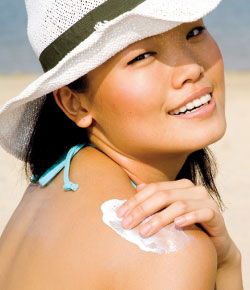The manufacturing of vitamin D stimulates the absorption of calcium and phosphorus in our intestines. Calcium is necessary for muscle contraction and bone development of our skeletal bones and teeth. Calcium is also very important in the transmission of nerve impulses through our central nervous system. Phosphorus is a main component of ATP (adenosine triphosphate); which is manufactured by the body through the food we eat and the oxygen we breathe. ATP is energy and it maintains and repairs all our body's cells. The American Medical Association (AMA) now recommends 10 minutes of direct sun several times per week to obtain vitamin D levels.
In areas where sunlight is limited, it becomes necessary to supplement, although the proper dosage is currently disputable.
Hence, the sun plays a major role in the health of our bodies. However, the sun can also wreak havoc on our bodies, the skin in particular. We, as skin professionals, know that overexposure to the sun produces accumulative damage in our skin tissue, resulting in free radical damage, DNA destruction, lowered skin immunity, collagen breakdown, melanocyte dysfunction, and worse, malignant cancerous lesions. So at what point did tan skin become so desirable?
History reveals to us that sunbathing became fashionable in the early part of the 20th century. There were certain doctors, at that time, who recommended sunbathing to their patients as a means for vitamin absorption and "general body toning," hence, sunbathing became En Vogue, with the fashion industry complying with less bathing suit material and more exposed skin. Tanned skin became a symbol of health and affluence.
Cosmetic suntan product formulations did not show up on the market until the 1940s, with the first commercial suntan product being manufactured. Miami Beach pharmacist, Benjamin Green cooked up a cocoa-butter cream on the stove and tested it on his bald head. He found, in his experiment, that the emollient rich cocoa-butter produced a tan instead of a burn, thus introducing the first commercial suntan product in 1944.
It was not until the 1980s that consumers became aware of the risks of tanning and the association of irresponsible, excessive sunbathing with cancer risk, creating a boom in the cosmetic suntan/sun protection industry. SPF 15 formulations were the standard in the 1980s and recommended by FDA standards. At that time, a consumer could find a broad range of suntan products on the market; suntan lotions, sun blocks, suntan mousses, suntan extenders, suntan enhancers, and self-tanning products.
In the early 1990s, as scientists became aware of the damaging effects of UVA rays, in addition to UVB rays, the introduction of "physical sun blockers," offering broad-spectrum protection, to both UVB and UVA rays,  became readily available on the market. Before this time, sun screens only offered protection against the burning UVB rays. Titanium dioxide was the "star" active ingredient at this time. With the advancement of technology, scientists offered a way to micronize the titanium dioxide to be more readily absorbed by the skin, making the ingredient more desirable in cosmetic preparations, due to the elimination of the thick, chalky white residue that you once only saw on beach lifeguards. Consumers in the 1990s were also looking for more natural alternatives, in their food and their personal care products, compelling cosmetic companies to create and formulate "chemical-free sun blockers," with added botanicals and antioxidants, such as aloe vera, chamomile, vitamin C, and vitamin E.
became readily available on the market. Before this time, sun screens only offered protection against the burning UVB rays. Titanium dioxide was the "star" active ingredient at this time. With the advancement of technology, scientists offered a way to micronize the titanium dioxide to be more readily absorbed by the skin, making the ingredient more desirable in cosmetic preparations, due to the elimination of the thick, chalky white residue that you once only saw on beach lifeguards. Consumers in the 1990s were also looking for more natural alternatives, in their food and their personal care products, compelling cosmetic companies to create and formulate "chemical-free sun blockers," with added botanicals and antioxidants, such as aloe vera, chamomile, vitamin C, and vitamin E.
Present day sun care is more advanced and sophisticated, with consumer trends leaning toward higher SPF ratings, and a higher purity of their chosen sun care products and formulations, with organics on the forefront. There is also a trend in personal lifestyle choices that contribute to how the skin responds to the sun. Photo-toxicity and damage accelerates with personal lifestyle choices, some unavoidable, such as: Cigarette smoking, environmental pollutants, food pollutants, stress levels, and exposure to synthetic chemicals; some of these chemicals being present in personal skin care products, marketed as anti-aging or marketed as a luxury product, heavily fragranced with fancy packaging.
As present-day skin care professionals, we can educate our clients on photo toxicity/damage prevention, from topical sun care preparations to specific lifestyle choices. First and foremost, let us review topical sunscreens, chemical and physical. Chemical sunscreens work by absorbing UVR rays and physical sunscreens work by reflecting UVR rays, thus altering the way the body responds to the UVR rays.
Chemical Sunscreens:
- 4-Methylbenzylidene camphor (4-MBC)
- Octyl methoxycinnamate (OMC)
- Padmate O
- PABA
- Octocrylene
- Ensulizole
- Homosalate
- Benzophenone-4
- Avobenzone
Overall, chemical sunscreens are not recommended due to toxicity concerns, such as: Allergies, photo-sensitivities, hormonal disruption, and increased oxidative damage.
Physical Sunscreens:
- Zinc Oxide
- Titanium Dioxide
Physical sunscreens fall in favor due to their low capacity to penetrate the skin, low toxicity rating, and the superior UVA protection they offer.
Most sunscreen formulations also include antioxidants in their preparations to further protect the skin from free radical activity that could result in cellular damage. In addition to your sunscreen, It is very beneficial to include and apply topical antioxidants daily, as part of a skin care regimen. These would include:
- Vitamin C
- Vitamin A
- Vitamin E
- Polyphenols
- Carotenoids
- Resveratrol
- Coenzyme Q-10
Educating and recommending a proper sunscreen is an integral approach to protecting your client's skin, however, proper application and lifestyle guidelines are equally important. The use of a sunscreen has limited capabilities of protection, especially if it is not used correctly. For example, instruct your clients to apply their sunscreen 30 minutes prior to outside activities and to apply liberally, not "patchy." Sunscreen should also be reapplied every two hours or after any water activity.
Advise your clients on peak hours of high UVR activity, which is from 10 a.m. to 3 p.m. This is the time frame when you are most likely to burn if not protected. Additionally, hats, sunglasses, and umbrellas are recommended during peak hours.
Heightened resistance to UV damage starts with a healthy immune system. Educate your clients on the importance of sleep and stress reduction. Consuming organic fruits and vegetables also supports immune function, while also protecting cells from free radical activity.
Similarly, supplementation of fish oils (EPA, DHA) plays a role in cell membrane integrity and is a natural anti-inflammatory, which acts in supporting and protecting the skin from UV exposure and accumulative sun damage.
Sun care is a lifestyle choice. Protecting the skin from sun damage and cancer takes a holistic approach. Sun care requires a balanced lifestyle; nutritive food and supplements, efficient rest and stress reduction; proper sunscreen usage and application; purchasing broad-spectrum sunscreens with physical filters; daily application of topical antioxidants in the form of serums and moisturizers that possess efficient delivery systems, such as liposomes; utilizing hats, sunglasses, and umbrellas during peak UVR activity; and last, but not least, responsibly acquiring the vitamin D we all need for proper body functioning.




 Keri Berardinelli is the owner of La Verte Wellness Spa, located in Willoughby, Ohio. Specializing in holistic skin care and body detoxification, she is a licensed aesthetician and a certified colon hydrotherapist with a background in education, having educated for Pevonia Botanica and Ilike Organic Skin Care. Berardinelli now manages her spa business, full time, and provides education to her clients on the mind, body, spirit connection to health and beauty. This email address is being protected from spambots. You need JavaScript enabled to view it.
Keri Berardinelli is the owner of La Verte Wellness Spa, located in Willoughby, Ohio. Specializing in holistic skin care and body detoxification, she is a licensed aesthetician and a certified colon hydrotherapist with a background in education, having educated for Pevonia Botanica and Ilike Organic Skin Care. Berardinelli now manages her spa business, full time, and provides education to her clients on the mind, body, spirit connection to health and beauty. This email address is being protected from spambots. You need JavaScript enabled to view it.
Want to read more?
Subscribe to one of our monthly plans to continue reading this article.